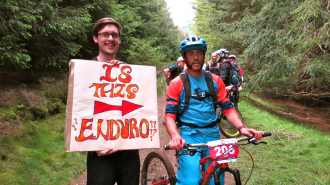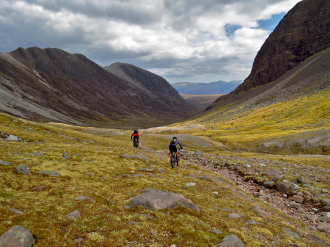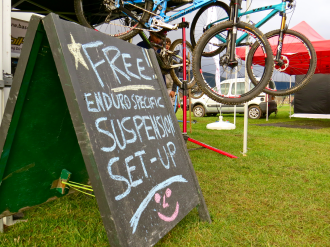Enduro Training by Huw Oliver (Glenmore Lodge Associate Mountain Bike Instructor)
Enduro Training
By Huw Oliver
Enduro is the newest phenomenon to hit the world of mountain biking, and its popularity has exploded so quickly in the last three or four years that there are many people out there still scratching their heads and wondering just what exactly all the fuss is about!
So, a quick rundown:
‘Enduro’ is a race format and is, roughly speaking, the mountain biking equivalent of a car rally. Racers must complete a circuit, usually by pedal power alone, and along the way ride timed ‘special stages’. The total time taken for all of the special stages (usually four or five) gives them their overall standing. The special stages will tend to be gravity-based, although there may well be a climb or two thrown in to keep you working hard! The distances between the special stages are called transfer stages, and these have a time limit placed on them, although they don’t count towards a rider’s ‘race’ time.
Although this format is nothing new in motor sports, there are several features of it that have made it attractive to an awful lot of mountain bikers! Firstly, the ideal bike for enduro must strike a balance between descending speed on the special stages, and the ability to pedal back up to the next stage. In short, a trail bike, which is what the vast majority of us already ride. Secondly, enduro races tend to be held on trails that offer a bit of everything – some nice climbs, fast descents, and some more technical. Again, isn’t that what most of us ride week in, week out? (There’s a pattern emerging here). Finally, because it’s a relatively new format, there is no tendency towards elitism, and at a given race here in Scotland you might find yourself with an ex-downhill professional in front of you just as easily as you might find your usual riding mates. Accessibility is the reason that enduro has taken off, and for many people it is the perfect way to give racing a go if you feel the need to scratch a competitive itch!
‘Training’ for an event might seem like a daunting prospect, and with enduro being such a patchwork of different demands on both bike and rider, it might seem like there aren’t enough hours in the day to cover all the bases. But again, help is at hand, because for a rider who is thinking to them themselves that they might just give this sort of thing a go, the likelihood is that they are already doing exactly the right things. Forget the gym, specific diets and heinously expensive new bike parts; the things that can help us to ride faster in a race are the same things that will help in our everyday riding.
Is there a climb that you can never quite get up clean? Try again until you are more confident, and hopefully fitter. That ride that looks good on the map? You won’t know until you go and try it. Got a great little local descent? See if you can keep up with that friend who has always been faster than you on it. Long days out on the bike and a willingness to challenge your existing abilities don’t cost a penny, but given time they’ll transform your riding more noticeably than that new, lightweight handlebar or saddle. Even at a race there are things to be learned. Whoever is the top step of the podium didn’t get there by accident, so watch their body position and riding style through a difficult section of trail to pick up clues and tips on how best to tackle it.
As well as improving you existing abilities, it can help to think about ways to get the most out of the bike you’re riding. Sometimes it can be tempting to blame our tyres on the days that we can’t seem to find grip anywhere, but it might be the case that a bit of experimentation is needed with tyre pressures, suspension settings or handlebar height. These are relatively simple adjustments to make, and local bike shops tend to be keen to pass on this knowledge when asked. Getting to know your bike and what works for you is hugely important if want it to perform at its best in a race, and some pre-race maintenance can help to avoid the disappointment of a mechanical mid-stage! Likewise, a bike maintenance course can be a great way to familiarise yourself with adjusting settings and keeping them in fully-working order, and one that can pay for itself in the end.
It might seem easy to say that the best way to get faster is simply by going out and riding, but at the end of the day it’s true. The most valuable thing that it will do is to give you confidence in your own abilities and experience. Many people find the idea of entering their first race a daunting one, and it is a common worry that they might be well behind the pace of everyone else. If that’s the case, then get yourself to an enduro race and take a look around – you won’t see many serious looks and thousand yard-stares, but you might hear groups of mates comparing times, or spectators shouting encouragement to riders crossing the line. There are levels of racing to suit everyone, and outside of the course tape, everyone will be more concerned about whether you’re having a good time rather than your time for stage 3.
If you’re in Scotland or northern England and you think that all of this might be for you, then you’re in luck. Returning for its second year, the city of Perth is hosting the Fair City Enduro in mid-October. A grass-roots enduro race that’s perfect for first-time racers, expect flowy race stages, friendly crowds, and even a bit of fancy-dress if you want to. For more information see the website here: Fair City Enduro
See you there!


